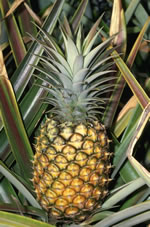GM Pineapple  Even with our
eyes closed, we can single out the tangy taste of a pineapple from among
the concoction of flavors in a fruit salad. Even with our
eyes closed, we can single out the tangy taste of a pineapple from among
the concoction of flavors in a fruit salad.
Native to Central and South America, pineapples were introduced to Europe by Christopher Columbus in 1493. It was in the 16th century when they were introduced to Asia where most of the major pineapple canning industries are found. Pineapple is considered the most widely marketed tropical fruit accounting for around 44% of total trade. An excess of 12M tons of pineapples were produced all over the world as of January 2001. Annual world production of pineapples has tripled during the last 30 years. Based on a Food and Agriculture Organization estimate (2000), the top five growers of pineapple are Thailand (2.281M Mt), Philippines (1.524 M Mt), India (1.44M Mt), Brazil (1.353 M Mt), and China (1.318 M Mt). The genetic diversity of pineapple is being studied by several research organizations. Aside from this, pineapples are genetically modified to resist pest and viruses and to possess the delayed ripening trait. The organizations doing the research are the Ministério da Agricultura e do Abastecimento of Brazil (EMBRAPA - http://www.embrapa.br) together with L’organisme Scientifique Francias Spécialisé en Agronomie Tropicale (CIRAD - http://www.cirad.fr) and the Hawaii Agricultural Research Center (HARC - http://www.hawaiiag.org/harc/). |
Related topics: Summary Report on the Global Status of Commercialized Biotech/GM Crops - [View the 2004 report] Transgenic Crops - [Click Here] Extensive Study on Bt Cotton - [Click Here] Download the complete copy of the ISAAA Briefs on Global Status/Review of GM Crops - [Click Here] SciDev.Net's dossier on GM crops - [Click here] Global Status of Approved Genetically Modified Plants - [Click here] |
| Home :: Global Status :: CBT Update :: Info Resource :: Events :: BICs :: Directory :: About Us :: Editorial Policy | |
Copyright © 2006. CropBiotech Net. |
|